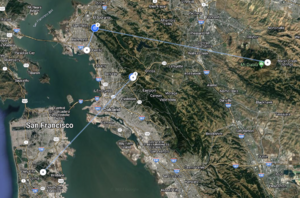Bay Area Backbone: Difference between revisions
m (→Plans) |
|||
| Line 28: | Line 28: | ||
==== Notes ==== |
==== Notes ==== |
||
The connection to Fish Ranch appears active, as Fish Ranch indicates an active link on the radio. This would suggest that the San Bruno end is correctly pointed and powered, but not yet connected to the rest of the AREDN network. |
The connection to Fish Ranch appears active, as Fish Ranch indicates an active link on the radio. This would suggest that the San Bruno end is correctly pointed and powered, but not yet connected to the rest of the AREDN network. |
||
| + | |||
| + | ==== Plans ==== |
||
| + | Current plans for a site visit in August 2022. The goal is to replace one of the AREDN nodes at the site (the NSM5) with a more powerful radio, as well as complete the work to bring up the link to Fish Ranch. We will also investigate adding a link to CCCC. |
||
| + | |||
| + | === CCCC === |
||
| + | '''Status''': Proposed |
||
===Black Mountain=== |
===Black Mountain=== |
||
Revision as of 19:43, 26 July 2022
The Bay Area Backbone Project is building solid, fast, links between major high sites in the Bay Area, which in turn supports a more stable mesh network. Backbone sites are permanent locations, not dependent on amateur radio operators' homes or difficult to access places.
Fish Ranch / ORCA
San Bruno Mountain
Status: Equipment installed. Powered. Link active to San Bruno.
Connection: Non-AREDN, airFiber 5 GHz.
Notes
Dish has been checked and is power, and shows a four bar, active link status to San Bruno (re: site visit 22nd, July 2022). However the device does not connect to the UISP tool because the WAN connection to Matt Peterson's is not currently connected, Matt believes is is unplugged at his end.
Cooperation
This link is provided in cooperation with Matt.
San Bruno Mountain
Fish Ranch / ORCA
Status: Equipment installed. Appears powered.
Connection: airFiber 5 GHz.
Notes
The connection to Fish Ranch appears active, as Fish Ranch indicates an active link on the radio. This would suggest that the San Bruno end is correctly pointed and powered, but not yet connected to the rest of the AREDN network.
Plans
Current plans for a site visit in August 2022. The goal is to replace one of the AREDN nodes at the site (the NSM5) with a more powerful radio, as well as complete the work to bring up the link to Fish Ranch. We will also investigate adding a link to CCCC.
CCCC
Status: Proposed
Black Mountain
Status: Proposed
Fire Station 8
Status: Proposed
CCCC
Mount Diablo
Status: Equipment installed. Active.
Connection: Non-AREDN, airFiber 3 GHz. Acts as DtD.
Notes
Connects via DtD over non-AREDN radios, so appears as wired AREDN connection, even though it isn't.
Plans
Re-evaluate the battery system and determine why it fails to provide the constant power required for all the equipment.
Richmond Field Station
Status: Equipment installed, Active.
Connection: Non-Ham, 5 Ghz AC gen2, unknown equipment.
Notes
Connects via DtD over non-AREDN radios, so appears as a wires AREDN connection, even though it isn't.
Mount Diablo
CCCC
Status: Equipment installed. Active.
Connection: Non-AREDN, airFiber 3 GHz.
Note
Connects via DtD over non-AREDN radio.
Richmond Field Station (RFS)
CCCC
Status: Equipment installed, Active.
Connection: Non-AREDN, 5 Ghz AC gen2, unknown equipment.
Notes
Connects via DtD over non-AREDN radio.
Black Mountain
San Bruno Mountain
Status: Proposed
Fire Station 8
San Bruno Mountain
Status: Proposed
San Rafael
...
Notes
DtD connected nodes
The backbone is currently being constructed using Part 15 devices acting as bridges between AREDN nodes. The AREDN nodes connect to bridges via the DtD port / VLAN 2. This essentially puts every node at every location in the Backbone on the same VLAN. Consequently, every broadcast from any node connected directly to any Backbone point will have its traffic retransmitted to every other node. This probably isn't a good thing. Additionally, today the Backbone is a tree (disconnected in place) at the moment, but one day might become a loop or a graph. This would improve redundancy. However, at that point we're introducing loops into out VLAN where broadcast traffic could cycle around continually causing a storm.
It probably makes more sense to reconfigure the Part 15 devices as the AREDN "WAN" (not really the Internet in this case) and create explicit tunnel between specific AREDN endpoints. This is similar to how the Southern California Mesh does it.
